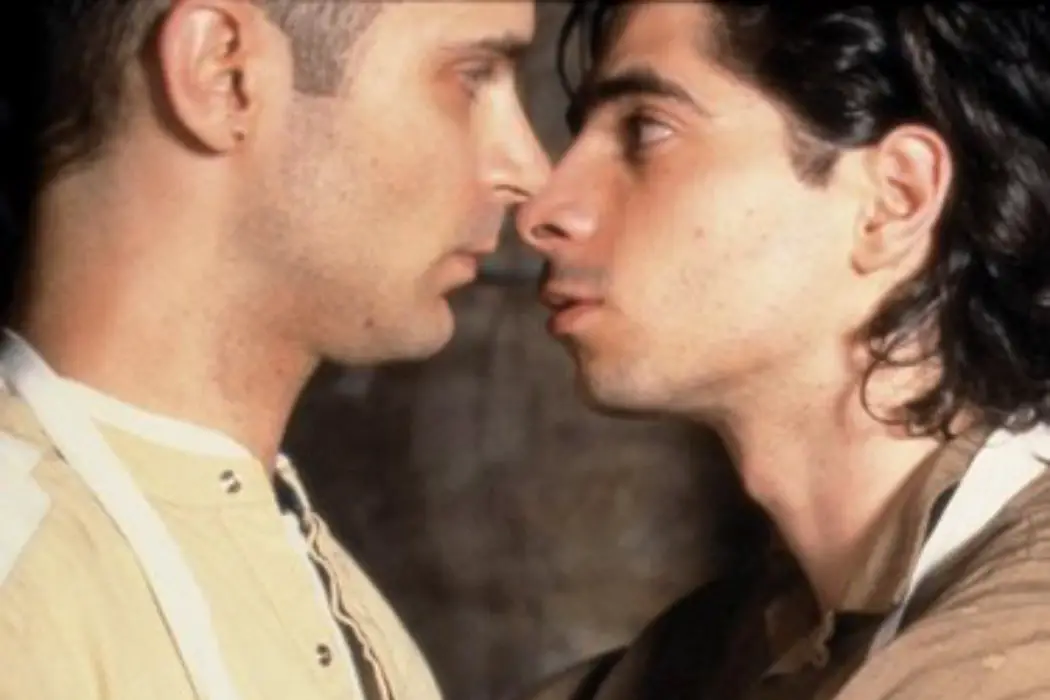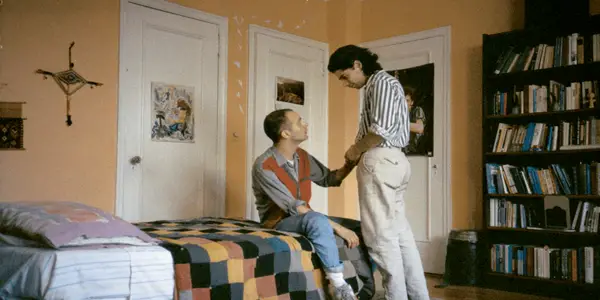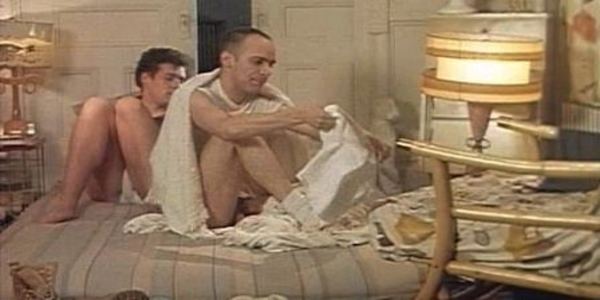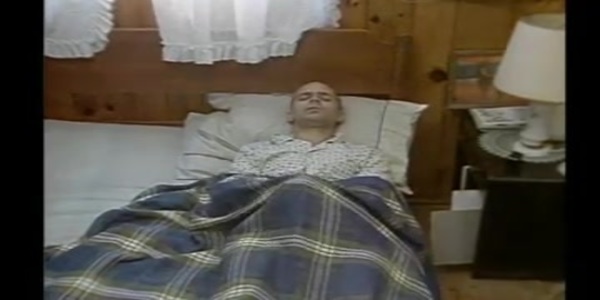Queerly Ever After #5: Interview With FUN DOWN THERE (1989) Director Roger Stigliano & Co-Writer Michael Waite

Amanda Jane Stern is an actress, writer, and director from…
Queerly Ever After is a bi-monthly column where I take a look at LGBT+ films that gave their characters a romantic happily-ever-after. There will be spoilers. If you didn’t get a chance to check out my review of Fun Down There in part 1, do so here, and then come back to this interview.
I recently saw Fun Down There at The Quad in New York City, afterwards I reached out to the married couple behind the film to see if they would be open to an interview. Below is my interview with Co-Writer/Director Roger Stigliano and Co-Writer/Lead Michael Waite. Answers have been edited for length and clarity. I conducted these as two separate interviews but have combined them here as one.
Roger Stigliano: You know, I never really thought about being a filmmaker until I saw Antonioni’s La Ventura. It was a stunning revelation to me, I had no idea that a movie could be like that. Not shot, counter shot, moving from wides to mediums to close, and every single cliche that gets attached, it didn’t have any of them it seemed to me, at the time at least. So, I was so excited and I think that’s literally when I started thinking about making a movie.
So I came out of this whole European, German art-film thing that I watched a lot of in the 80s. And I was very young, and naive and I thought well, I can make a movie like that, because I love those movies, those long, long, long takes. I was very, I wanna say reactive, but that’s not quite right. I looked at everything I saw on TV, I used to turn the sound off and look at it, and I’d think oh, I still know what’s going on.
Now that’s considered a strength of western cinema, but I hated that, if I can turn the sound off and the camera is telling me exactly what to look at and what it means then, I just found that really obnoxious. I felt totally manipulated. Of course now I understand that every movie is a manipulation. My movie manipulates the audience, just in a different way. But back then I thought, I’m gonna make a movie that’s not manipulative, how about that?
When I saw it, Nick (McCarthy, the programming director for NewFest) at The Quad who introduced it, it had a quote from you like you wanted to make a movie that was different from everything else.
Roger Stigliano: I want to correct that, because I was totally in awe of a lot of the Germans, and a lot of the Italians, I wanted to make a movie that was completely different from television. And so I thought the way to do that was static setups, incredibly long takes, no drama. I was really an extremist back then, if television does this I’m not gonna do it, if television uses that shot I’m not gonna use it, if television edits this way I’m not gonna edit that way.
In a weird way I was controlled by the thing I hated. Each step of the way doing the opposite, of course I look back now and think that’s not very sophisticated is it? Just reacting to something I dislike. But now I have this movie that I think people either really like or they’re really like, what was the point of this? Why did anybody make this? And then I just thought, well, let’s make it a gay story. That kind of came second. I wanted to make a narrative that was very austere.
Now when you started writing a script were you originally writing alone or were you and your husband (Michael Waite) already writing it together?
Roger Stigliano: We basically wrote it together from the beginning, but I was the pushy, obnoxious one so I got to make all the final decisions.
Were you already together at that point?
Roger Stigliano: Yeah. We got together in 1981.
How was it working together?
Michael Waite: It went fine. Because it was so low-budget – we did a lot of stuff on our own, made meals, housed people. We work together really well.
When I watched it, the thing that stood out most to me, that it reminded me most of was Parting Glances. The reason it reminded me is because you both used the time constraint thing, yours is a week, theirs is a day, but also a lot of the filming style, and there were big party scenes in both movies where you’re following all these different characters doing their own thing at this party.
Roger Stigliano: Shooting that party scene was a nightmare. It put me off party scenes for a while.

What happened when you were filming it?
Roger Stigliano: I had decided I was gonna shoot a certain way, because I wanted it to be like a Chantal Akerman movie. But, I didn’t actually know how to shoot the conventional way. I didn’t go to film school. And I hated it, and because I hated it, I didn’t learn it. So I just had this idea in my mind, there were gonna be fixed wide shots of long duration and that’s the whole movie, I think there’s once where we move in to a close-up at the beginning. But then when it came to do the party scene I was like, okay, we’re just gonna set the camera up and we’re gonna leave it here, but you know that’s not easy to do.
There’s a reason why people go handheld or they do all this movement, and I was like, I can’t do that, it’s not in the rules that I made up. So it was very hard to get a sense of a party without moving the camera. Plus I used a whole bunch of non-actors, which is not necessarily a bad thing, but I also didn’t know how to direct actors. And I look back now at that movie and I think I was in the middle of New York City, I could have filled every role with the most talented actors that exist. But I didn’t because I didn’t know how to audition people, I didn’t know how to direct people. I was intimidated by actors so I said, oh, let’s get all our friends together and make a movie.
How did you find the cast? Cause I figured this was probably a non-union movie.
Roger Stigliano: It was a non-actor movie, except Michael was trained. He studied with Stella Adler. And the woman who played Greta, the restaurant owner, also studied at Stella Adler. And Michael basically taught me on the fly some things about how to direct actors without totally freaking them out. Without giving them line readings. I was like why can’t they just do what I tell them to do and he was like because that’s not how acting works.
Michael Waite: We used some people we knew, like Paul who sang the Edith Piaf song was a friend of ours, we just thought he was so unusual we should put him in a movie because he just went around as himself in a dress singing Edith Piaf songs.
And the men that played Joseph and Angelo, were they friends, or how did you find them?
Michael Waite: Yeah, Angelo was a friend of Roger’s, and Joseph was a good friend of mine at the time.
I know that the people playing Buddy’s parents were actually Michael’s parents.
Roger Stigliano: Oh, yes. They were actually Michael’s parents. It was so funny, and strange.
It’s very sweet thinking about that though.
Roger Stigliano: It is very sweet. And they were very game. They were very on board. They just were so excited to be part of a movie.
It is a strong script, and actually, I found it very interesting, there were a lot of discussions that Buddy and Joseph have about how to have sex and not get AIDS and be safe about it and I wanted to know is that a conversation that was actually common?
Roger Stigliano: Oh my god, yes! I had that conversation with all my gay friends, and I had that conversation with a lot of people that I slept with beforehand. I was on a tear that I was not gonna fall victim to this thing that nobody really knew much about. It’s the last thing anybody wants to talk about but, when death is the alternative, you’re like okay it’s embarrassing but on the other hand, so we did, a lot of us had that conversation with people before we slept with them, or with our friends to try to keep them safe. I knew I had to address AIDS somehow, but I didn’t want it to become an AIDS movie. I mean thousands of people were dying around us in the 80s, at the same time life went on and it was a lot of joy and a lot of fun and a lot of nightlife. And for a long time, I lost a few people to AIDS who were friends of mine, but that didn’t happen until the 90s. So, when I made the movie, AIDS had been going on maybe 8 years, and it had gotten a huge amount of press and lots of people were dying, and yet, I didn’t know anybody. The world I was in, this East Village art and rock scene didn’t seem affected, even though I knew it must be. I wanted to make a movie that showed this world where it wasn’t really being touched by it but it also wasn’t denying it.
Michael Waite: We were kind of on a mission then too, this whole AIDS thing was kind of new and our objective was to say that things can still be okay in this dark time.

So how autobiographical was the film?
Roger Stigliano: If it’s anybody’s biography, it’s Michael’s, not mine. Because he came from upstate when he was 18 and moved to the city to study acting and was very naive. So I modeled his character on him somewhat. That’s how we ended up using his parents.
Michael Waite: It’s loosely based on me. It’s my dad and my stepmom in his lake house that we filmed, and my step-sister played my sister. Other than that, I left immediately at 18, I didn’t stay around in a small town, so I was a little bit more savvy, but I drew on my life experience. And then I was 28 when I did the movie, so I had to play somebody who knew less than I did, cause I had already been living in New York for 10 years and was more or less jaded. It was amazing when I moved to New York, I was studying at the Academy of Dramatic Arts and we could live in a dorm, there was a whole floor at Pace University that people who were going to school at the academy were living on, so I was this kid from a small town and I was like Oh my god there are all these gay people. And, like Buddy I was like oh, I guess it’s okay to be gay, these other people are okay with it so I guess I’m okay with it.
What was it like to approach such a provocative role?
Michael Waite: Roger really wanted the explicit stuff, he thought it was important and I agreed that it would be, and also didn’t quite realize at the time it would have as big an audience as it did. I even think I found myself on a naked actors site. When you’re young you don’t always think about consequences of what everything’s gonna mean.
Movies are still terrified of male nudity.
Michael Waite: Yes still. And then it did get a lot of attention, and I’m not sure, but it might be that it was a gay movie that I didn’t go further in my acting career.
I know back then a lot of straight actors didn’t want to take on LGBT roles, but then actual LGBT actors didn’t either because it was the idea that then it boxes you in. Did that ever cross your mind when you and Roger were writing the script?
Michael Waite: It’s hard to remember now. I guess I must have thought about it, I think I just dove in. Again, I didn’t realize it would have this broad audience. At one point I was in a magazine in Germany voted like the 4th sexiest man of the year or something. I think I was above Emilio Estevez at the time.
What’s definitely very striking is the first time Buddy hooks up with Joseph, he starts crying afterwards.
Michael Waite: Yeah, because for the character it was such a release. He’d built up for so long and felt so isolated that finally this release happened and it was amazing.
Was Fun Down There your first film?
Michael Waite: It was my first feature.

How long did you film and what was the budget?
Roger Stigliano: It was a little over $40,000, now that seems like an enormous amount of money for a little indie. Somebody asked me about 10 years ago, how did you spend that much? And I was like, for one it was film dude, and film is expensive. We shot for 3 weeks in New York, then we had to break, and then we went upstate to shoot a week there. So it was 4 weeks total.
Clearly my thing is happily-ever-afters with this column, do you feel that this movie has a happily-ever-after?
Roger Stigliano: Yeah, I think so.
Michael Waite: Yes I do. Buddy found himself and he’s much happier than he was at the beginning of the movie. He’s on a good path, I think.
And who would you call the central couple? Do you think it’s Buddy and Angelo or Buddy and Joseph?
Roger Stigliano: Probably Buddy and Joe. Yeah, because you know another feature of sort of hipster gay life in the 80s on the lower east side was for, at least, men were not monogamous, that was like a bit of an absurd idea. It was like, you and I, we can be together, of course we’ll have sex with other people, but it’ll be you and me against the world. If that makes any sense at all.
Michael Waite: Buddy and Joseph, that’s what comes to mind when I think of the movie. He’s putting him on that path to be happy.
That’s exactly how I interpreted it.
Roger Stigliano: Ok, great. That’s how we were living. That’s how Mike and I were living.
I figured that because he was moving in with Joseph they were clearly the end game. At the end of the day they’d come back to each other. Whoever else they sleep with, it was the two of them.
Roger Stigliano: Yeah, and that’s how Mike and I lived. We kind of pledged to be a couple, within all our promiscuity. And it was great, but we were really primary in each other’s lives and somehow that worked. So that’s what I think I was modeling with Buddy and Joe and Angelo.
Film Inquiry thanks Roger Stigliano and Michael Waite for taking the time to speak with us!
Does content like this matter to you?
Become a Member and support film journalism. Unlock access to all of Film Inquiry`s great articles. Join a community of like-minded readers who are passionate about cinema - get access to our private members Network, give back to independent filmmakers, and more.
Amanda Jane Stern is an actress, writer, and director from New York City. She received her BA in Film, Television & Interactive Media and Theater Arts from Brandeis University. She loves regaling whomever will listen with her endless lists of fun facts and knowledge of film history. Follow her on twitter and instagram @amandajanestern













